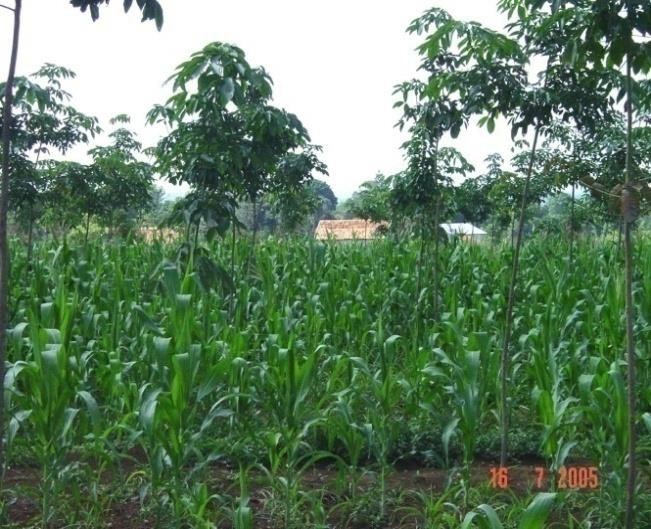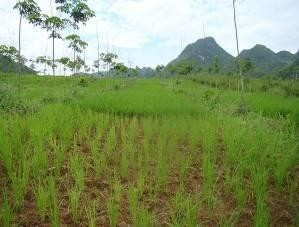-
Potential CSA models
-
Agro-forestry (intercropping of agricultural crops with forest trees)
Ngày đăng: 22/05/2017Lượt xem: 1797Agro-forestry" is the concept of integrated production systems, combining agriculture and forestry, rather than a production practice. In this document, the agroforestry practice is used to talk about the intercropping practice of agricultural crops with forest trees, with the aim to generate more income for farmers before harvesting forest trees. At the same time, it also creates the source of cover materials, soil protection, anti-erosion when the forest plants have not closed canopy and restrict weedAgroforestry practices include the cultivation, management and care of forest trees according to conventional techniques, and in the early stages (in the period of basic construction, 1 to 5 after the planting of forest trees), intercropping of short-term crops (peanuts, soybean, black beans, maize, upland rice, ginger, ginger, etc.) in the gap between rows of forest trees. Need fertilizer and intercrop care. When the forest tree is large enough and the canopy cover almost all of the ground, intercropping is not appropriate. In the Northern mountainous areas in particular and in the country in general, farmers often intercrop different types of trees, including short-term trees, fruit trees, and forest trees in the VAC production system (garden-fishpond-animal husbandry).
At present, some agroforestry experiments are being implemented by the Institute of Agricultural Science and Technology of the Northern Mountainous Agriculture & Forestry Science Institue, with rubber trees, a new plant in Son La, Dien Bien and Yen Bai. However, the application of agroforestry with rubber trees is still limited, due to the large area of rubber plantations under the management of the rubber joint stock companies in the area. In addition, the ICRAF project (2010- 2016) is being implemented in all three provinces, and some agroforestry models are being developed (intercropping, tea / fruit trees intercropping with forestry and food crops). These models are currently only in the testing phase.


Figure 1: Figure 1: Maize intercropped with rubber (left;), upland rice intercropped with rubber (right)
The main difficulties in expanding agro-forestry applications.
- Generating on input cost and labor cost for intercropping plants
- Lack of suitable intercropping cultivars
- Market limit for some intercropped products
Table 1. List of selected sites with agro-forestry applications
Place Applicant Year (*) Area (ha) Type of tree Son La province
1Thuan Chau District (Tong Lanh, Tong Co communes) Household 2009 150 Food crops intercropped with rubber trees on sloping land
2Yen Chau district (Chieng Pan, Chieng Sang communes) Household 2009 265 Food crops intercropped with rubber trees on sloping land
3Moc Chau district (Xuan Nha commune) Household 2011 50 Food crops intercropped with rubber trees on sloping land Dien Bien province Household Food crops intercropped with rubber trees on sloping land
1Dien Bien district Household 2010 10 Food crops intercropped with rubber trees on sloping land
2Tuan Giao district Household 2011 15 Food crops intercropped with rubber trees on sloping land
3Muong Nhe district Household 2010 10 Food crops intercropped with rubber trees on sloping land
4Muong Cha district Household 2010 12 Food crops intercropped with rubber trees on sloping land Yen Bai district Household
1Van Yen district (Chau Que Thuong commune) Household 2012 4 Food crops intercropped with rubber trees on sloping land
2Yen Binh district (Phuc An and Vinh Kien communes) Household 2012 15 Cassava intercropped with eucalyptus or acacia (*) The area is listed at the year in the table. However, at the present time the area and application situation may be different.
Source: nomafsi.com.vn
Cây dữ liệu:Dữ liệu liên quan:- Agroforestry and the development of integrated production systems
- Growing corn
- Cover the ground and minium soil preparation
- Fish culture in rice fields (rice-fish)
- Intercropped with legumes
- Growing grass for livestock development and management of soil erosion
- Make Terraced to grow trees
- CSA (Climate Smart Agriculture) project: Capturing synergies between mitigation, adaptation, and food security
- CSA project in Vietnam: Capturing the synergies between mitigation, adaptation and food security (GCP/INT/139/EC)
- Science and technology program for sustainable development of the North West region: Achievements and cooperation orientations
- Aus4Equality Program
- Liên kết website
- Thăm dò ý kiến
-
Bạn thấy nội dung trên chuyên trang CSA như thế nào?Phong phú, đa dạngTạm đượcCần bổ sung thêmBình chọnKết quả
|
Bạn thấy nội dung trên chuyên trang CSA như thế nào?
Tổng số:209 phiếu
|
|||
|---|---|---|---|
| Phong phú, đa dạng | 60,3 60,3% |
126 phiếu | |
| Tạm được | 3,3 3,3% |
7 phiếu | |
| Cần bổ sung thêm | 36,4 36,4% |
76 phiếu | |
Cục Trồng trọt - Bộ Nông nghiệp và Phát triển nông thôn
Địa chỉ: Số 2 Ngọc Hà, Ba Đình, Hà Nội
Điện thoại: 0243-8234651; FAX: 0243-7344967; Email: tt@mard.gov.vn
© Hệ thống cơ sở dữ liệu csa - Version 1.0
Được phát triển bởi Cty TNHH Tư vấn đầu tư và phát triển Tâm Việt







